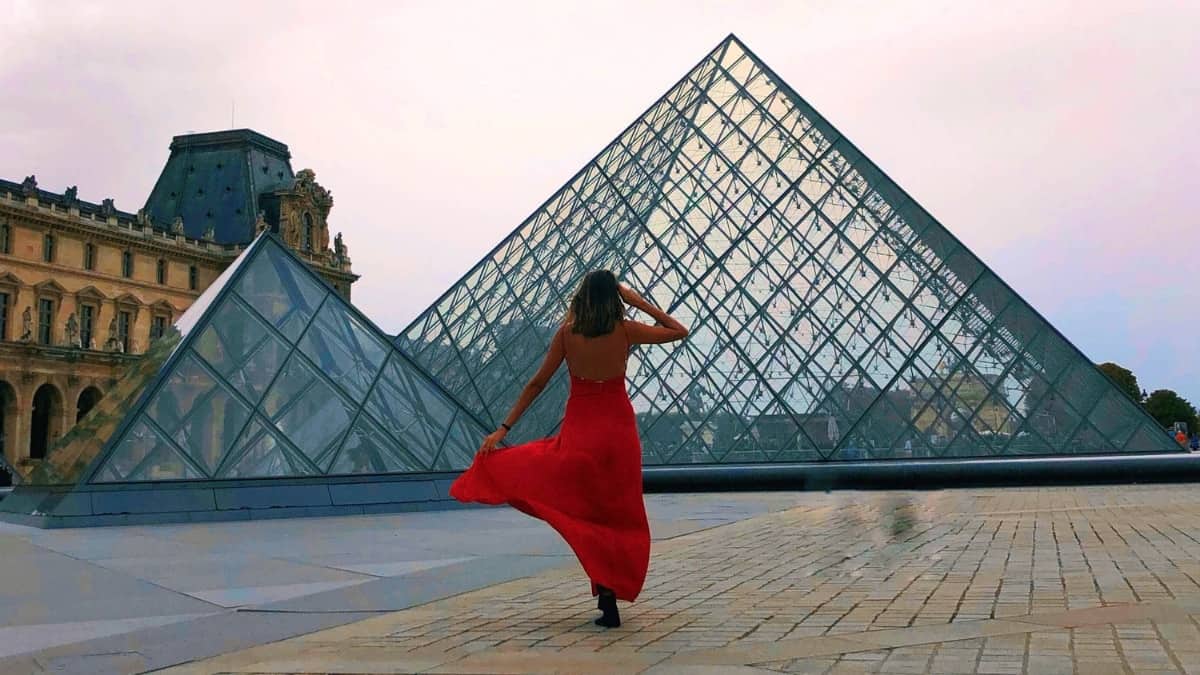
The Louvre Pyramid is one of Paris’s three most recognizable landmarks, after the Eiffel Tower and the Arc de Triomphe.
It is a large glass and metal Pyramid located in the main courtyard of the Louvre Museum in Paris.
Inaugurated in 1989, it quickly won over art lovers and became an integral part of the Parisian Art Museum.
It served as the museum’s main entrance and was intended to provide a modern contrast to the classical architecture of the Louvre’s historic buildings.
The construction was controversial at the time, as many people felt that its modern design clashed with the traditional architecture of the Louvre.
However, the Pyramid has since become a beloved landmark of Paris and an iconic symbol of the Louvre Museum.
Today, the Louvre Pyramid is a popular meeting place for tourists and locals and is often used as a backdrop for photographs and films.
This article shares everything you must know about the pyramid before visiting the Louvre Museum.
Table of Contents
Why was Louvre Pyramid built
In this section, we take you through the various incidents that led to building one of the most famous Parisian landmarks.
Space Crunch at Louvre Museum
In the early 1980s, the Louvre Museum was a world-class art museum bursting at its seams.
It had the finest collections of art globally, yet they were running out of space to display.
Because of the lack of space, the galleries were disjointed, and the visitor experience was poor.
So much so that there were only two public bathrooms to accommodate the 2.5 million visitors who came to relish the art annually.
To add to the space crunch, the French Minister of Finance had claimed the Richelieu Wing of the building for their offices.
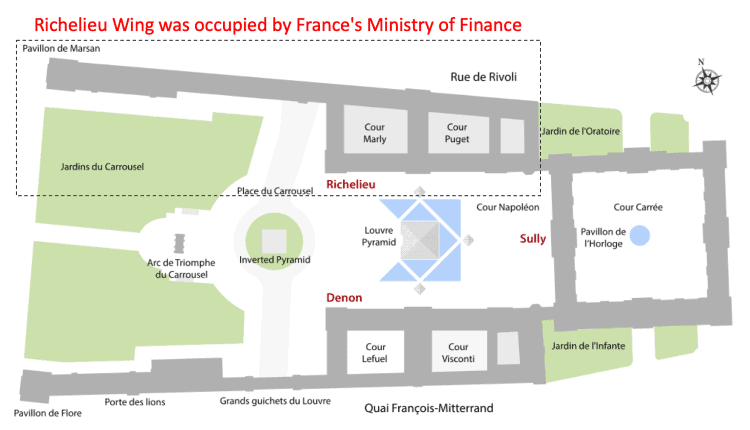
The museum couldn’t use one wing to display art exhibits out of the three available wings.
Louvre Museum’s repeated requests for space went unheeded.
The Louvre had to do something quickly if it had to maintain its position as the world’s best art museum.
Art-loving French President enters the fray
And slowly, the Museum’s luck turned.
In 1981, socialist François Mitterrand was elected the French President.
Mitterrand doubled investment in the arts and announced that The Louvre was his top priority.
In the same year, Mitterrand announced the Grand Louvre project, which would include redesigning the museum and adding space.
He also made sure the Art Museum got the Richelieu Wing back.
Mitterrand identifies the architect
In 1983, François Mitterrand invited Chinese-American architect Ieoh Ming Pei and gave him the commission to modernize the Louvre.
The Grand Louvre project was so crucial for Mitterrand that he decided to forgo an open competition, making many French architectural firms unhappy.
The President’s unilateral decision infuriated many, but he stuck to it.
Idea of ‘Louvre Pyramid’ is born
Architect Pei’s solution was simple yet effective.
He decided to place a new entrance in the Cour Napoléon, the courtyard enclosed by the Museum’s existing buildings.
The entrance would be in the middle of the courtyard, surrounded by a transparent Pyramid.
The transparent glass structure was to solve two purposes:
- Offer the visitor a ‘grand’ feeling of arrival
- Offer space for visitor services
- Light the underground space
Being transparent, the structure wouldn’t obscure the historic Louvre Museum’s buildings around as well.
Under the glass Pyramid, he planned to create a reception, functional areas, and a network of corridors to facilitate access to the art collections.
Architect IM Pei’s solution added more than 92,000 square meters (990,279 square feet) of floor space to the Museum and doubled the exhibition space from 31,000 square meters to over 60,000 square meters.
With this solution, the Louvre Museum could seamlessly direct visitors to 14.5 km (9 miles) of corridors and 403 rooms.
Opposition to Louvre Pyramid
Pei unveiled his 71-foot-tall glass-and-metal Pyramid, but he didn’t get the response he was expecting.
Almost everyone was against it, and the criticism was brutal on both aesthetic and technical grounds.
Many called it ‘Pharaoh Francois’ Pyramid.’
A 1985 New York Times story summarised the criticisms:
It is an architectural joke, an eyesore, an anachronistic intrusion of Egyptian death symbolism in the middle of Paris.
Construction
Despite the opposition, work on the glass Louvre Pyramid began.
While the project was IM Pei’s singular vision, it was also a massive collaborative effort.
Unprecedented archeological excavations in the Cour Napoléon and the Cour Carrée unearthed the Louvre’s medieval foundations.
The Pyramid had a square base and was constructed entirely of glass segments and metal poles.
Ninety-five tons of steel and 105 tons of aluminum support the structure.
While the Louvre Pyramid is 21.6 meters (71 ft) tall, its square base sides are 34 meters (112 ft).
It has a total of 673 glass segments – 603 rhombi and 70 triangular-shaped.
This main Pyramid, which is in the same proportions as the Great Pyramid of Giza, is used as an entrance to the Louvre’s courtyard.
Three smaller ones on three sides surround the main pyramid.
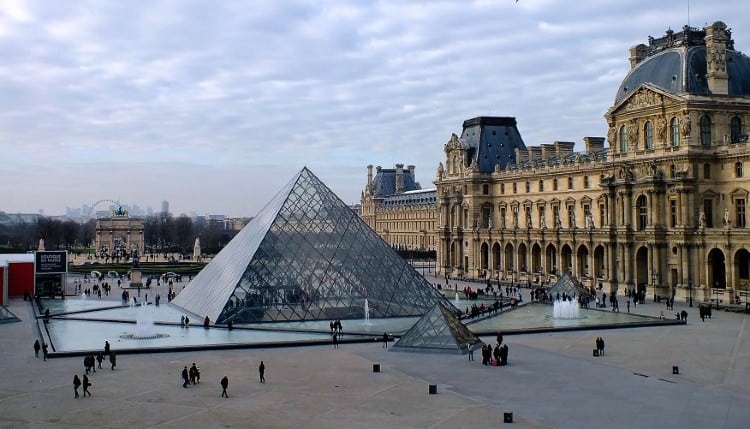
Besides providing aesthetic appeal, these pyramids are also a means to lighten the Museum’s collections downstairs.
Pyramid entrance
The Louvre Museum has four entrances – the Pyramid entrance, the Porte des Lions entrance, the Carrousel entrance, and the Porte de Richelieu entrance.
The main Pyramid entrance is the most popular because the 21-meter (71-foot) high glass structure makes for great photographs.
The Louvre gets around 30,000 visitors a day, which results in long lines outside the Louvre Glass Pyramid.
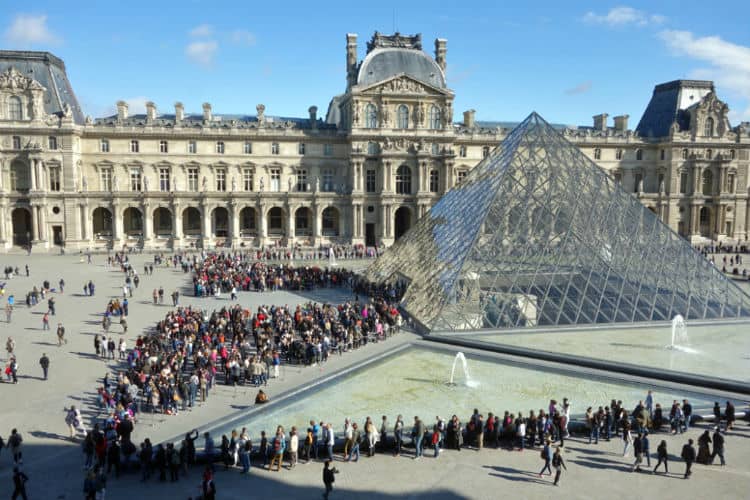
When you haven’t already bought Skip the Line Louvre tickets, you join this line at the end and wait your turn for the security check.
Once you clear the security, you are inside the air-conditioned Louvre Glass Pyramid.
Now you must stand in line at the ticketing counter to buy your Louvre Museum ticket. Thankfully, this second line moves fast.
Once you have paid the entrance fee and bought your tickets, you can enter The Louvre.
How to skip the long lines
However, if you buy your Louvre tickets online, you can skip these long lines.
Here is a step-by-step guide to what happens when you decide to buy the tickets online in advance.
Step 1: Buy the art Museum’s tickets in advance
>> Louvre Museum Ticket – €20 per adult 18+ years
>> Guided tour of The Louvre – €95 per adult 18+ years & €65 per child aged 10 to 17 years
>> Private guided tour of the Louvre (when experience at the Louvre is more important than the cost of the ticket)
Step 2: Reach the pyramid and walk past the long lines
Step 3: Once you near the Pyramid entrance, look for the sign’ visitors with tickets.’ In French, this sign should read ‘Avec Billet.’
Step 4: Show the guard your online ticket (you can show the ticket in your email; there is no need for printouts).
Step 5: You merge with the security check line inside the glass Pyramid.
Step 6: Once the security check is over, you walk into the Museum since you already have the tickets.
When you buy your tickets in advance, you can avoid waiting in the sun.
Especially during peak months (which happen to be summer months!) when the waiting time can be over 2 hours.
Yet another way to beat the crowd is to visit the Louvre Museum at night.
If you aren’t sure which Parisian art gallery you want to visit, check out our analysis of the Musee d’Orsay vs. Louvre. Even if you decide to visit Musee d’Orsay, you can always visit the Louvre after dark to see the glass Pyramid all lit up.
Inverted Pyramid
The Inverted Pyramid wasn’t part of IM Pei’s first Louvre Museum redesign in the 1980s.
He designed and installed it in 1993 as part of Phase 2 of the Louvre Museum’s renovation.
Also known as the Louvre Pyramide inversée, it is a skylight constructed in the Carrousel du Louvre, an underground shopping mall in front of the Louvre Museum.
It is similar to the pyramid, which acts as the Louvre entrance on the ground, except that it is upside down.
To reach the Inverted Pyramid, you must descend the stairs near the Arc de Triomphe du Carrousel and walk towards the main underground shopping arcade.
You can find the stairs on either side of the Arc de Triomphe du Carrousel.
Keep walking, and soon enough, you will reach the intersection of two main underground walkways, which is where the Inverted Pyramid is suspended in all its glory.
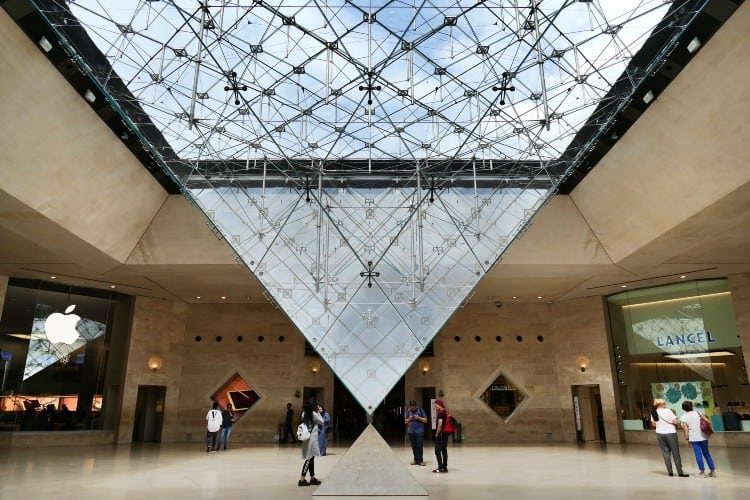
The inverted Pyramid’s base can be seen from the outside, but nobody notices it because it is part of the roundabout of Place du Carrousel.
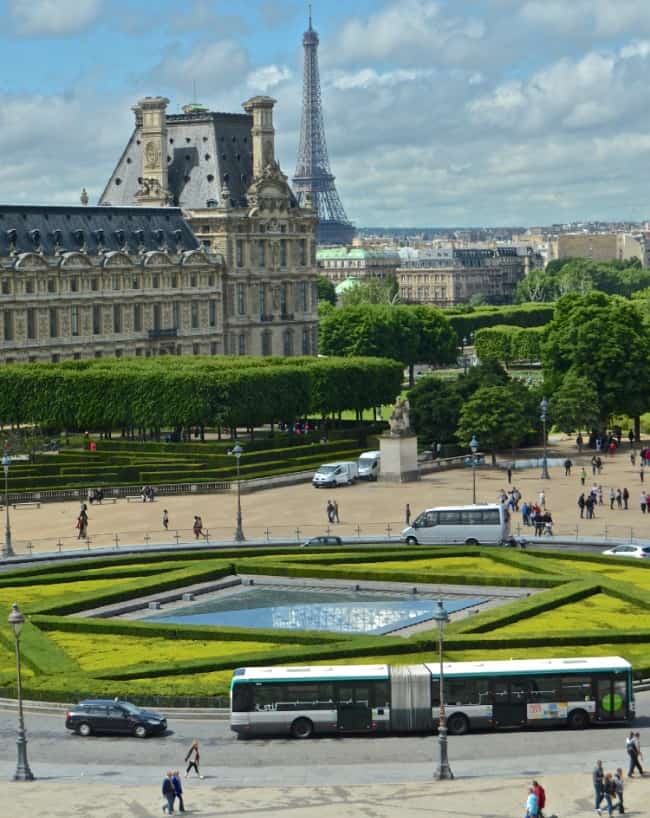
Louvre’s Inverted Pyramid entrance
The Inverted Pyramid orients visitors towards the Louvre entrance on the lower floor.
Many names refer to this entrance:
- Louvre Carrousel entrance
- The mall entrance to the Louvre
- Inverted Pyramid entrance
If you are reaching the Museum by Metro, it is best to enter through this underground entrance.
If you have already bought your Louvre Museum tickets online, you can skip all the lines and walk into the Museum.
Interestingly, this doorway also leads to the same part of The Louvre Museum as the main pyramid entrance on the ground floor.
Tip: For Lines 1 and 7, the Metro stop for the Louvre Museum is ‘Palais Royale-Musee du Louvre.’
Some tourists visit the Eiffel Tower and the Louvre Museum on the same day. If you also plan to do the same, follow the links for directions:
– From Eiffel Tower to the Louvre Museum
– From Louvre Museum to Eiffel Tower
Louvre Pyramid facts
Here are some interesting facts about the Pyramid in the Louvre Museum.
IM Pei took his time to accept the commission
In 1983, when IM Pei got the invitation from French President François Mitterrand to help him redesign the Louvre, he kept it a secret from his firm for four months.
Pei made secret trips to Paris to study the project’s scope, better understand it, and then commit. Finally, after four months of research, he accepted.
Pei wasn’t French enough
The people of France were not happy with the President’s choice of the architect for the Louvre’s upgrade.
They thought IM Pei was not French enough to be entrusted with the critical task of redesigning the treasured Parisian landmark.
‘What are you doing to our great Louvre?’
The Louvre’s Pyramid and redesign project lasted almost a decade, and in the early years, Pei was publicly mocked.
Speaking on a documentary on America’s PBS, Pei said:
When I first showed the idea to the public, I would say 90 percent were against it.
The first year and a half were really hell. I couldn’t walk the streets of Paris without people looking at me as if to say: ‘There you go again. What are you doing here? What are you doing to our great Louvre?'”
Fear of project getting canned
Since the Grand Louvre was a long project, there was a real fear that it wouldn’t be supported if Mitterand wasn’t re-elected.
The people behind the project decided to construct it out of sequence and built the glass Pyramid structure before the base.
They thought it would be difficult to ditch the project midway if something existed in concrete form.
As luck would have it, François Mitterrand got re-elected and served his two full terms of seven years.
Pei even impressed the future President
Jacques Chirac, who was the mayor of Paris in the early 1980s, was against the glass pyramid idea.
However, when Pei showed Jacques Chirac a full-scale mock-up, he was happy with what he saw and started supporting it.
Jacques Chirac would become the French President after Mitterrand and serve one full 7-year and 5-year terms.
The glass on the Pyramid is special
Pei insisted on total transparency in the pyramid so that the historic buildings all around could be seen.
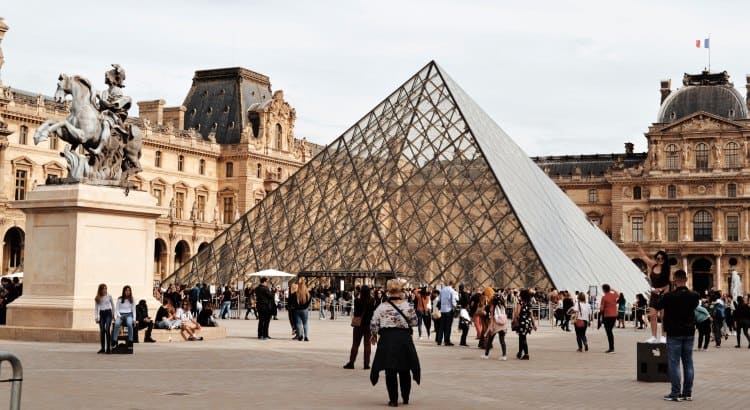
However, it was challenging because most glasses had a faint bluish or greenish tint back then.
He roped in Saint-Gobin to find a type of glass that was transparent, light, and strong enough to be used for the pyramid.
The glass company rose to the challenge by creating what they named ‘Diamond Glass.’
After months of research, they developed the 21.52mm extra clear laminated glass, which has unbeatable mechanical properties and high optical quality.
The company built a special electric furnace to remove the iron oxides and eliminate the glass’s green reflection.
Enough glass to make two pyramids
The ‘Diamond Glass’ is laminated like automobile windshields, so its fragments won’t scatter if any glass breaks due to impact.
The 1,800 square meters (19,375 square feet) of glass in the pyramid consists of 675 rhombus-shaped glass pieces and 118 triangles.
As a precaution, Saint-Gobain made enough glass to build two pyramids, but it never needed repairs in the last thirty years.
The Satan connection
The Louvre Pyramid saw its share of opposition. But the most interesting of all was when conspiracy theorists accused IM Pei of using 666 glass panes on the pyramid.
Many times, the architects announced that the design had 673 glass panes, but few believed them.
Some even accused the French President of especially asking for 666 glass panes as a tribute to Satan.
People had to wait 25 days to see the Pyramid
Mitterand inaugurated the finished pyramid on 4 March 1989, and it was telecast on Television for the public to see.
However, the public could only visit the Grand Louvre’s Pyramid on 29 March.
By now, the French had warmed up to the idea of a futuristic structure in the courtyard of their historic Louvre.
Many pyramids followed the Louvre Pyramid
In the year the Louvre Pyramid opened, Pei built large glass pyramids on the roof of the IBM Somers Office Complex, the regional headquarters for the IBM corporation, in Westchester County, New York.
A few years later, Pei returned to his pyramid structure at the Rock and Roll Hall of Fame in Cleveland, Ohio again.
Cleaning the glass pyramid is a challenge
Cleaning the 21-meter (71-foot) sloped structure was always going to be difficult.
Tall structures are usually cleaned by carriage systems dropped from the top of the building or lift bucket systems, but in the Louvre Pyramid’s case, these would be useless.
Initially, the authorities hired mountaineers to climb the pyramid and clean the glass.
In 2002, a Seattle-based company introduced a new ‘double breadbox-sized robot’, which the Louvre adopted.
The Robot was controlled by a remote control and climbed on the tracks on the pyramid.
The Robot held on to the glass via suction cups and used a squeegee and rotating brush to clean.
Louvre Pyramid in the Da Vinci Code
In the 2006 film The Da Vinci Code, the protagonist Robert Langdon (played by Tom Hanks) meets French Police Captain Bezu Fache in front of the pyramid.
During the movie, Captain Bezu Fache refers to the Pyramid as ‘a scar on the face of Paris.’
Louvre surpasses even Pei’s expectations
When the Grand Louvre project was initiated in 1983 to accommodate more visitors, the art museum was already receiving around 2.5 million visitors annually.
By the time the upgrade was over in 1989, the Museum was welcoming 3.5 million visitors.
In 2019, 30 years after the glass pyramid in the Louvre was inaugurated, the world’s best art Museum got more than 10 million visitors.
That’s a four-fold increase, which we are sure keeps the Louvre authorities up at night.
Fun fact: Did you know that around 85% of these 10 million people visit the Louvre to see Mona Lisa?
Architect of Louvre Pyramids
Ieoh Ming Pei was a Chinese-American architect born in 1917 in Guangzhou and raised in Hong Kong and Shanghai.

In 1935, he moved to the United States and studied architecture at the Massachusetts Institute of Technology before joining the Harvard Graduate School of Design (GSD).
A significant jump in his career came in 1948 when Pei got recruited by New York City real estate magnate William Zeckendorf.
Image: Wikimedia
Pei worked for Zeckendorf for seven years before starting his independent architectural firm, Pei Cobb Freed & Partners.
He is known for his bold designs and precise geometries in his projects, spanning his career over six decades.
Some of his best works are:
- Museum of Islamic Art, Doha (2008)
- Suzhou Museum, Suzhou (2006)
- Miho Museum, Kyoto (1997)
- Rock and Roll Hall of Fame, Cleveland (1995)
- Bank of China Tower, Hong Kong (1990)
- Le Grand Louvre, Paris (1989)
- John F. Kennedy Library and Museum, Boston (1979)
- East Building at National Gallery of Art, Washington DC (1978)
- Dallas City Hall, Dallas (1978)
On 16 May 2019, the world-renowned architect passed away at the age of 102.
Sources
# Wikipedia.org
# Tickets-paris.fr
# Pariscityvision.com
# Re-thinkingthefuture.com
The travel specialists at TheBetterVacation.com use only high-quality sources while researching & writing their articles. We make every attempt to keep our content current, reliable and trustworthy.
Recommended Reading
1. Interesting Louvre Museum facts
2. Fun read: When Louvre statues talk back
3. Attractions near Louvre Museum
4. Guided Tours of Louvre Museum
5. Louvre Museum and Seine River Cruise Tickets
